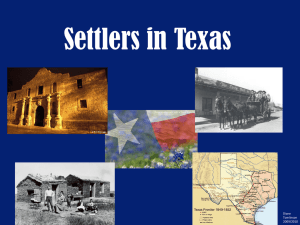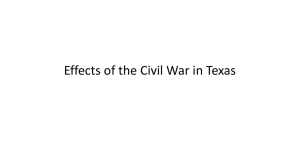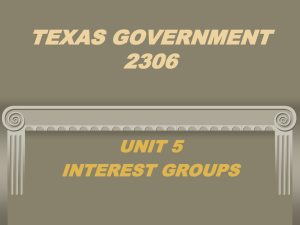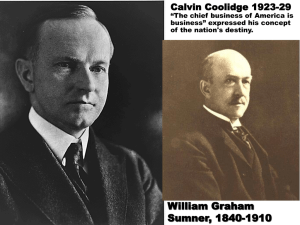Unit 10, Section Three Notes
advertisement
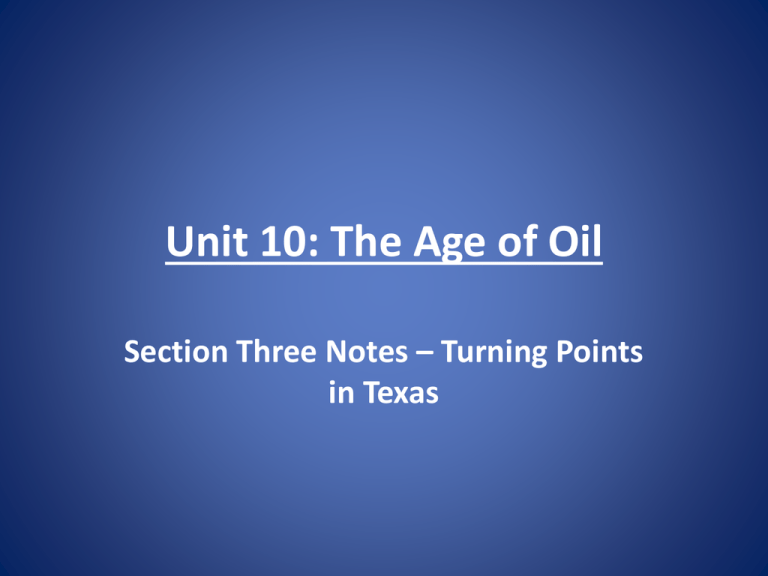
Unit 10: The Age of Oil Section Three Notes – Turning Points in Texas What is a Turning Point? Closing of the Open Range Date: End of the 1880’s • Before the end of the open range, cattle could roam free and ranchers could let their herds drink water and feed on the frontier. Ranchers could also drive their cattle north to market. • The invention of barbed wire and the building of railroad lines deep into the heart of Texas led to closing of the open range. • As a result of fencing and the closing of the open range, cattle drives ended and people began fighting over land and water rights. Open Range Continued… Effects of the Closing of the Open Range: • Landforms like rivers and aquifers were then fought over. Who owned the rights to water? • People were able to move further into west Texas, and railroads and towns soon followed. • Cattle drives ended, and ranchers then transported their cattle on the nearest Texas railroad. Railroad Growth After 1870 Date: After 1870 • Texas was always considered a frontier state, with a smaller population and less available transportation than other U.S. states. • Texas knew that if they were ever going to compete economically with the rest of the country, they would need a better railroad system that would connect the large state across rivers, plains, and hills. • Around 1870, Texas cities and towns began to set aside money to build railway lines. Once they were built, it helped to end cattle drives and the open range. Railroad Growth Continued… • The fact that Texas had many different types of landforms made travel difficult before the building of the railroads. • By 1900, over 10,000 miles of track were laid in Texas. It helped with the transportation of goods, people, and news. High scale and commercial farming became bigger because of the ability to ship your crops to larger markets on trains. Creation of the Texas Railroad Commission Date: April 3, 1891 • As the railroads expanded, more people and businesses relied on the railroad industry for all of their transportation needs. Because of this, railroads sometimes over-charged people for their services to make a higher profit. Creation of the Texas Railroad Commission Continued… • The Texas legislature passed a law that allowed the Texas Railroad Commission to regulate the rates and operation of the railroad industry so they wouldn’t be too powerful. • The TRC made sure that people were treated fairly. This is still part of their job today. Hurricane of 1900 Date: September 8, 1900 • Before the Hurricane of 1900, Galveston was a prospering city. There were very few government agencies created to protect citizens from natural disasters. • The Hurricane of 1900 almost completely destroyed the city of Galveston, leaving almost 8,000 people dead. It was considered the greatest natural disaster in the American 20th Century. Hurricane of 1900 Continued… • After the hurricane, the people of Galveston tried desperately to rebuild. They worked to build an allweather bridge so that they would always be able to reach the mainland. They also pumped sand into the city from the ocean floor to raise the city’s sea level. • Today, Galveston is a major port for cruise ships. The bridge that was built has improved transportation. Because of this hurricane, communications and government response during and after natural disasters have been improved. Spindletop Date: January 10, 1901 • Oil was used for kerosene in the 1800’s, but it had few other uses. Before Spindletop, many people looked for oil in Texas, but not much was found. • Patillo Higgins, a wildcatter, believed that oil would be found under Spindletop Hill. It was a hill surrounded by low plains. They struck oil on Jan. 10th. • After Spindletop, many people moved to Beaumont to try to make money off the oil boom. Spindletop Continued… • Patillo Higgins had a hunch that oil would be found under Spindletop Hill because of the shape of the land. The hill was surrounded by low plains. • Over 500 oil companies, such as Texaco, were formed within months of Spindletop. Then an man named C.M. “Dad” Joiner made the biggest oil discovery in the history of Texas. All of this led to the Texas Oil Boom, a boost in the Texas economy, and a development of cities and industries. C.M. “Dad” Joiner • He got his nickname for being known as the “Father” of the East Texas oil field that he discovered. The East Texas oil field stretched from Henderson and Kilgore to Longview and Gladewater. By 1938, he alone was worth $3 million, but sadly, he lost most of his wealth before he died. Completion of the Houston Ship Channel Date: 1914 • Houston was a growing city near the coast of Texas, but it was still difficult to get people and goods on ships through Buffalo Bayou’s narrow waterways. • In 1914, the Houston Ship Channel was complete, and the waterways of Buffalo Bayou were deepened and widened for larger ships to sail through. Completion of the Houston Ship Channel Continued… • The completion of the Houston Ship Channel led to a population boom in the area. Oil refineries and factories were soon built near the channel so that the companies could be close to the new transportation route. The Spanish-American War In 1895, the Cubans started a revolution against Spain for their freedom. America supported their fight for independence, especially after it was suspected that Spain destroyed the U.S. battleship Maine that was docked in Havana Harbor in 1898. This event caused America to declare war on Spain. People from all over America came to Texas to train at military bases, with the weather being similar to Cuba’s. The Rough Riders Lieutenant Colonel Theodore Roosevelt, later a U.S. President, came to Texas to recruit and train troops. Men of all ages joined his 1st U.S. Volunteer Cavalry. Known as the Rough Riders, his teamed trained in San Antonio and were the first U.S. troops to land in Cuba. They became famous for their defeat of Spanish troops at the Battle of San Juan Hill. Results of the Spanish-American War U.S. forces fought Spain in Cuba, the Philippines, and Puerto Rico. After defeating Spain and winning the war, the U.S. gained control of all those islands. Winning this war really expanded America’s foreign power in world politics. Also, Texas continued to play an important role in the training of U.S. troops for battle. Events Leading to World War I When World War I began in Europe in 1914, the Allied Powers – Great Britain, France, and Russia – were fighting the Central Powers – Germany, Austria-Hungary, and Turkey. Most Americans wanted to stay neutral, but Germany then sank a British passenger ship called the Lusitania, killing 1,198 passengers, including 128 Americans. Germany also promised Mexico to help them gain back their lost land from the U.S., including Texas. This made us declare war on Germany on April 6, 1917. American and Texan Involvement in World War I Once war was announced, many Americans volunteered, including 200,000 Texans. Before going to fight in Europe, many soldiers came to Texas to train. World War I was a dangerous and bloody war. Still, four Texans won Congressional Medals of Honor for their bravery in World War I. President Wilson had many advisors who were from Texas, including Edward M. House of Austin. Economic and Social Effects of World War I In order to help out the soldiers overseas, many Texans purchased war bonds to raise money for the war and gave up certain foods so that more food could be left for the men fighting. Texas’ oil, agricultural, and lumber industries production increased. There was almost full employment in Texas at this time because of the wartime economy. Women became more involved in agriculture and business with the men gone. But at the same time, Germans in Texas faced discrimination. More than 5000 Texans died before Germany surrendered in 1918. World War I Leads to World War II After World War I, Germany and Italy were left crippled. The people of these countries felt desperate for leadership and soon turned to a new form of government known as fascism, which allows for a very strong central government led by one individual. Under fascism, the needs of the nation are more important than that of individual people. Adolf Hitler of Germany and Benito Mussolini of Italy began to expand their military forces.

